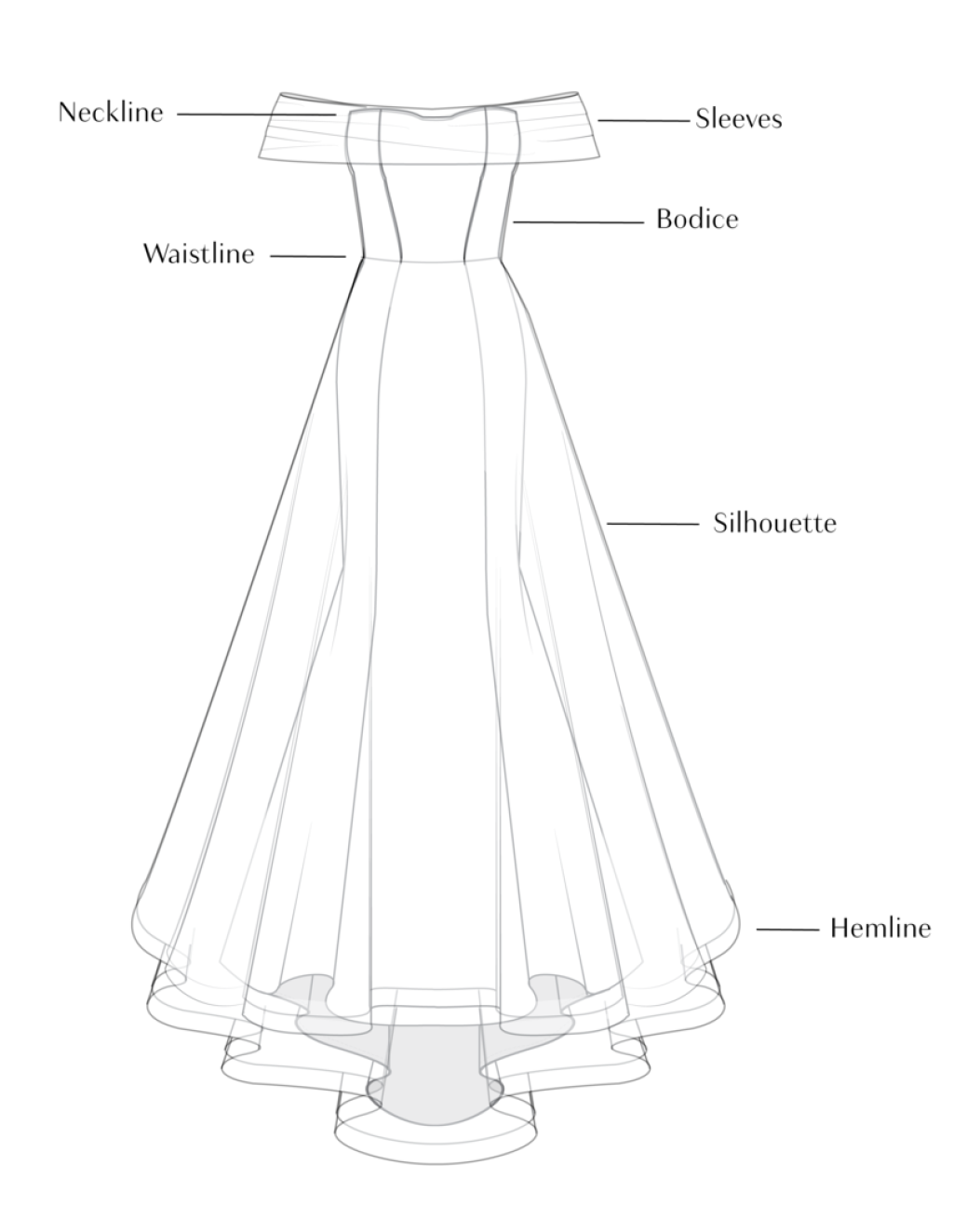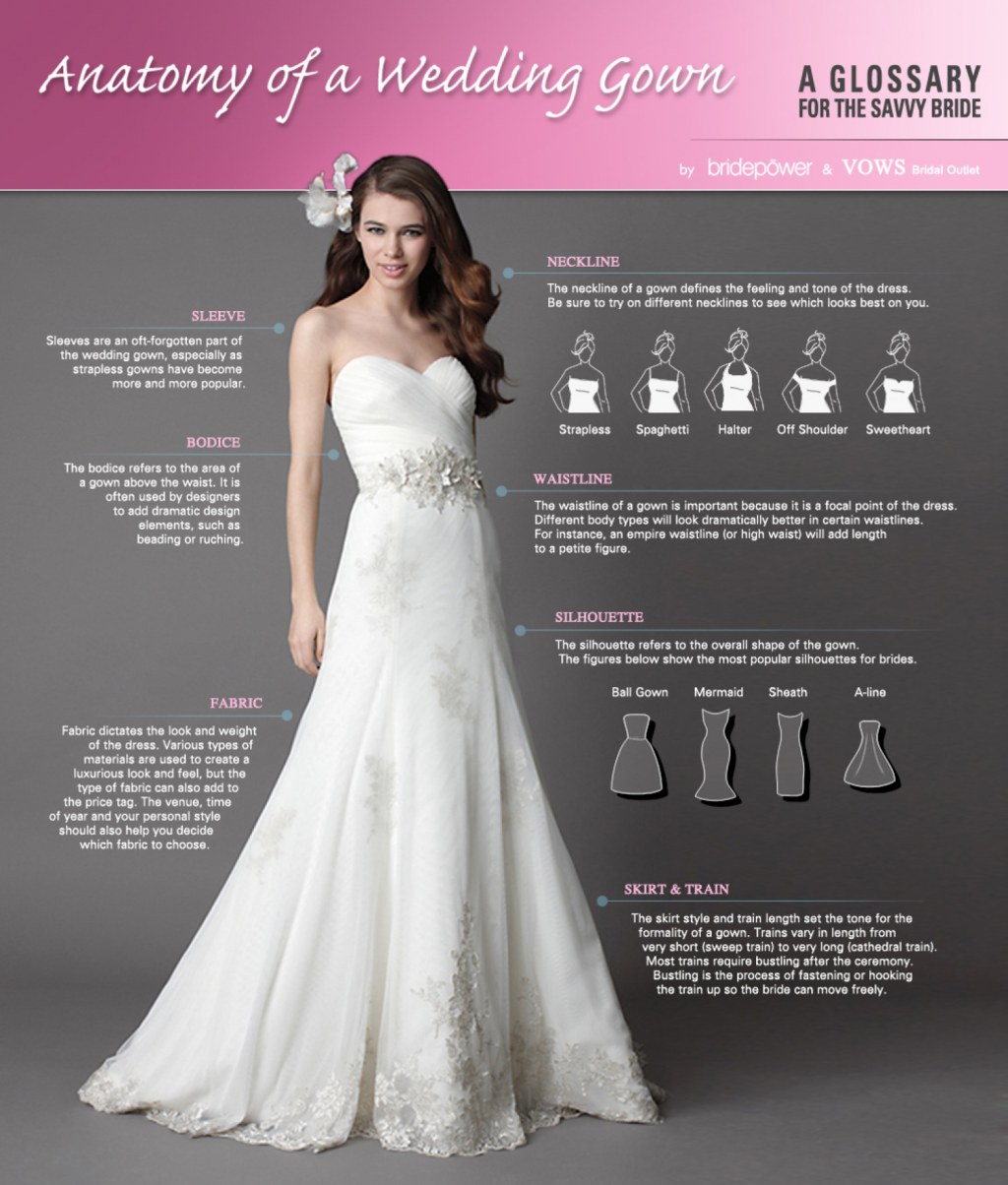Parts of a Gown
Introduction
Dear Fashion Enthusiast,
3 Picture Gallery:



Welcome to our informative article on the different parts of a gown. Gowns have long been a symbol of elegance and sophistication in the world of fashion. Whether you’re attending a formal event or a special occasion, understanding the various components of a gown is essential. In this article, we will explore the different parts of a gown, their functions, and how they contribute to the overall look and feel of the garment. So let’s dive in and unravel the mysteries behind these stunning creations!
Overview of the Parts of a Gown

Image Source: visual.ly
Before we delve into the details, let’s start with a quick overview of the various parts of a gown:
Part
Description
Bodice
The upper part of the gown that covers the torso.

Image Source: reneegrace.com
Skirt
The lower part of the gown that extends from the waist down.
Train
An extension of the skirt that trails behind the wearer.
Sleeves
Coverings for the arms, ranging from short to long.
Neckline
The shape and style of the opening at the top of the gown.

Image Source: visual.ly
Waistline
The point at which the bodice and skirt meet.
Embellishments
Decorative elements such as lace, beads, or sequins.
What Are the Parts of a Gown?
The parts of a gown can vary depending on the style and design, but here are the most common components:
Bodice: The bodice is the upper part of the gown that covers the torso. It is typically fitted and can have various necklines and sleeve styles.
Skirt: The skirt is the lower part of the gown that extends from the waist down. It can be full and voluminous or sleek and fitted, depending on the desired look.
Train: The train is an extension of the skirt that trails behind the wearer. It adds an extra touch of glamour and is often seen in formal gowns.
Sleeves: Sleeves are coverings for the arms and can range from short to long. They can be made of the same fabric as the gown or feature different materials and embellishments.
Neckline: The neckline refers to the shape and style of the opening at the top of the gown. Popular neckline styles include sweetheart, V-neck, and off-the-shoulder.
Waistline: The waistline is the point at which the bodice and skirt meet. It can be natural, empire, or dropped, depending on the desired silhouette.
Embellishments: Embellishments are decorative elements added to the gown, such as lace, beads, or sequins. They enhance the overall design and add visual interest.
Who Wears Gowns?
Gowns are worn by individuals attending formal events, such as weddings, galas, or award ceremonies. They are also popular choices for proms and other special occasions. Gowns are typically associated with elegance and are worn by people who want to make a statement with their attire.
When Should Gowns Be Worn?
Gowns are typically worn for evening events or occasions that require a more formal dress code. They are particularly suitable for weddings, charity balls, and black-tie events. However, the appropriateness of wearing a gown depends on the specific event and its dress code.
Where Can You Find Gowns?
Gowns can be found in various places, including specialized boutiques, department stores, and online retailers. Bridal shops are often a popular choice for finding wedding gowns, while formalwear stores offer a wide range of gowns for different occasions. Online platforms provide convenience and access to a vast selection of gowns from different designers.
Why Are Gowns Popular?
Gowns are popular for several reasons:
Elegance: Gowns exude an air of elegance and sophistication, making them a popular choice for formal events.
Style: Gowns come in a variety of styles, allowing individuals to express their personal taste and showcase their unique fashion sense.
Special Occasions: Gowns are often associated with special occasions, such as weddings and galas, where dressing up is part of the experience.
Red Carpet Glamour: Gowns are frequently seen on red carpets, worn by celebrities who want to make a memorable fashion statement.
Tradition: Wearing a gown can be a nod to tradition and cultural customs, particularly for formal events with specific dress codes.
How Are Gowns Made?
Gowns are typically made by skilled designers and dressmakers who specialize in creating intricate garments. The process involves several steps:
Design: The designer creates a sketch or concept for the gown, considering the desired style, silhouette, and overall aesthetic.
Pattern Making: A pattern maker creates a blueprint of the gown based on the designer’s specifications. This includes measurements and details of each component.
Fabric Selection: The fabric is chosen based on its suitability for the design and desired drape. High-quality materials are often used for gowns to ensure a luxurious look and feel.
Cutting and Sewing: The fabric is cut according to the pattern, and the different parts of the gown are sewn together by skilled seamstresses. This process requires precision and attention to detail.
Embellishments: If the gown requires embellishments, such as lace, beads, or sequins, these are carefully added by hand to enhance the overall design.
Fittings and Alterations: Once the gown is constructed, fittings are done to ensure a perfect fit. Alterations may be made to adjust the length, waistline, or other elements as needed.
Finishing Touches: The final touches, such as pressing and steaming, are done to ensure the gown looks pristine and ready to be worn.
Advantages and Disadvantages of Gowns
Advantages:
1. Elegance: Gowns are synonymous with elegance and can make anyone feel like royalty.
2. Versatility: Gowns come in a wide range of styles, allowing individuals to find the perfect gown for any occasion.
3. Statement Piece: Wearing a gown is a surefire way to stand out and make a lasting impression.
4. Variety: From ball gowns to mermaid silhouettes, gowns offer endless options for different body types and personal preferences.
5. Timeless Appeal: Gowns have a timeless appeal that transcends trends, making them a valuable addition to any wardrobe.
Disadvantages:
1. Expense: Gowns can be expensive, especially those made with high-quality materials and intricate designs.
2. Limited Use: Gowns are typically reserved for special events and may not be suitable for everyday wear.
3. Maintenance: Gowns often require special care and cleaning methods due to their delicate fabrics and embellishments.
4. Mobility Restrictions: Some gowns, particularly those with long trains or voluminous skirts, can limit mobility and make it challenging to move around comfortably.
5. Fashion Fads: While gowns have timeless appeal, certain styles and details may go in and out of fashion, affecting their long-term relevance.
Frequently Asked Questions (FAQ)
1. Can I wear a gown to a cocktail party?
Yes, you can wear a gown to a cocktail party, especially if the dress code specifies formal attire. Opt for a shorter gown or a cocktail-length gown for a more appropriate look.
2. Are gowns only for women?
No, gowns are not exclusively for women. Men can also wear gowns, particularly in certain cultural or ceremonial contexts.
3. How do I choose the right gown for my body type?
When choosing a gown, consider your body type and look for styles that flatter your figure. A-line gowns are generally flattering on most body types, while empire-waist gowns can accentuate the waistline.
4. Can gowns be altered?
Yes, gowns can be altered to achieve the perfect fit. Consult with a professional seamstress or tailor who specializes in formalwear alterations.
5. Are gowns appropriate for a daytime wedding?
The appropriateness of wearing a gown to a daytime wedding depends on the dress code specified by the couple. If the dress code is formal or black-tie, a gown would be appropriate. However, for a more relaxed or casual dress code, you may opt for a shorter, less formal dress.
Conclusion
In conclusion, understanding the different parts of a gown is essential for anyone interested in fashion and formal attire. From the bodice to the skirt, sleeves, and embellishments, each component plays a crucial role in creating a stunning and memorable gown. Whether you’re attending a wedding, gala, or special event, a well-designed gown can make you feel like the belle of the ball. So embrace the elegance and sophistication of gowns and let your personal style shine!
Final Remarks
Disclaimer: The information provided in this article is for general informational purposes only. The author and publisher assume no responsibility for any errors or omissions in the content above. It is always advisable to consult with a professional stylist or designer for personalized advice on gown selection and styling.
This post topic: Gown

